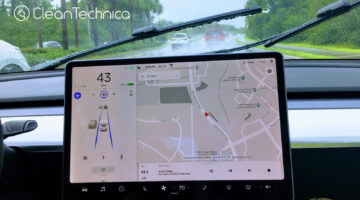This article is part of a short series. You can find Part 1 here.
That Time The Desert Almost Went Back In Time
While scientists can tell us what plants and animals existed during the last glacial period, it’s a difficult thing for present day humans to visualize, and it seems impossible to actually see for one’s self. But, occasionally nature gives us a peek.
In 2008, parts of the desert southwest got a small taste of what it was like during the last glacial period. Today, the deserts of the southwest and the Great Basin are dry, and sometimes bone dry. Sure, there’s still vegetation in most places, but it has to survive on just a few inches of rain per year that comes in short bursts during the monsoon season.
In 2008, something very unusual happened. Relatively strong remnants of a hurricane pushed highly unusual amounts of moisture into the Chihuahuan Desert.
After battering the coast near Brownsville, Texas, Hurricane Dolly moved inland and roughly followed the Rio Grande’s course toward New Mexico. By the time it reached El Paso, Texas and Ciudad Juarez, Chihuahua, it was no longer a hurricane, but still had a visible cyclone and other features of a tropical storm. The sudden influx of tropical moisture drenched the deserts and mountains of the region, causing flooding and even a few deaths.
In journalism, it’s said that “if it bleeds, it leads.” With the death and destruction from all of the water over, that’s where the news articles and even Wikipedia’s page on the hurricane generally stop. But, for people paying attention to nature in the area, this is where a very interesting story only began.
Dry arroyos (desert creeks that only have water right after monsoon storms) ran for days, especially in places where flood control dams held the water back. In some places near the mountains, these arroyos ran for weeks and even months, as the intermittent springs had been fully recharged. Playas (dry lakebeds) filled with water, temporarily putting them at levels not regularly seen for 10,000 years. Seasonal rivers all ran full of water, and the whole area felt like it had been transformed. In the months that followed, all of the extra moisture that had been deposited managed to stay put, as this all happened during the area’s regular monsoon season.
With all of this extra moisture on top of the regular monsoon season, the desert’s vegetation transformed into something even my grandfather had never seen before. Vines of some kind sprouted everywhere, covering the mesquite and chaparral shrubbery. Grass popped up everywhere. A number of other plant that I’d never seen in the desert before started sprouting up everywhere. What was once a mix of green and tan was all green.
All of the extra plants and moisture later affected the animal life, too. By two weeks after the storm, and for months after, there was a LOUD sound of crickets and other noise-making bugs every night. It also seemed like the population of cottontail rabbits and other small mammals exploded a few months later.
Months later, the vines dried up and became flammable, as did most of the grass. This led to an uptick of brush fires the next year, but in places that didn’t burn, there was no sign of any of the extra plant and insect life within 1–2 years. However, some places that are favorable to grass kept a lot more grass in the years following the storm.
Local scientists noticed all of this, of course. They concluded that with enough wet years, the desert is prepared to go back to being grasslands like such areas were during the last glacial period. In those days, we had huge animals, all of which are extinct today. Dire wolves, giant ground sloths, and even native horses all roamed the grasslands, among many other things. There were small and large lakes all over the lowlands, with snow-capped mountains where desert peaks and dry forests dominate at present.
Today, though, all of this is gone, and the desert has taken almost all of it all over, leaving only “sky islands,” or high mountains that harbor some of the diversity of life that once dominated the whole area.
Why People Didn’t Want To Farm
Of course, if you don’t live in the desert like I do, things were different back in the last glacial period. If you live up in the mountains or in Canada, ice dominated everything, so ancient humans generally didn’t spend much time there. If you live near an ocean, the water was further out back in those days, as much of the water was locked away in glaciers and inland seas.
Whatever affect a glacial period would have on where you live, it’s hard to dispute that the earth was a beautiful place. The deserts weren’t deserts. Snow-capped peaks extended much farther south. Large game that could easily feed a family or a tribe roamed everywhere, and was often quite easy to catch.
Many people today are tempted by the nomadic life, with over 1 million Americans living in RVs and many others embracing “van life,” so it’s not hard to imagine how ancient peoples would want to hunt and gather, moving with the herds and the water, or even with the seasons.
Farming and civilization really sucks in many ways, too. You get a lot less leisure time as a farmer, and you don’t get to be as close to nature. We also need to keep in mind that living in permanent housing (near one’s farm) is only a good thing if you can keep it sanitary, and that’s something that we’ve only mastered in the last 200 years. As Lies My Teacher Told Me points out, Europeans moving into the Americas are often portrayed in history books as civilized people, much like us today, wresting nature away from dirty, uneducated, backward savages who lived in grass huts. In reality, European-style housing and towns were nasty, awful places full of bedbugs, fleas, disease, and rodents. Plus, there was manure and sewage in the streets. When native Americans found that a shelter was getting infested with anything, they could just torch it and build new ones, while Europeans largely just lived in endless filth.
In Part 4, I’m going to continue discussing the reasons people don’t want to farm, and then get into the effects farming had on the planet. It’s a lot bigger than most of us think.
Featured image: path of Hurricane Dolly (2008), by NASA and Stormsupport (CC-BY-SA 3.0 license).
Appreciate CleanTechnica’s originality? Consider becoming a CleanTechnica Member, Supporter, Technician, or Ambassador — or a patron on Patreon.

- 000
- Advertise
- All
- Americans
- Americas
- among
- animals
- AREA
- article
- articles
- Books
- bugs
- build
- Canada
- Catch
- change
- cleantech
- Cleantech Talk
- Climate change
- continue
- day
- DID
- Disease
- Dispute
- Diversity
- Dolly
- Europeans
- family
- farm
- farming
- Features
- full
- game
- good
- great
- Green
- Guest
- High
- history
- housing
- How
- HTTPS
- huge
- Humans
- ICE
- image
- inches
- IT
- journalism
- large
- Led
- License
- Mexico
- million
- months
- Nasa
- Near
- news
- ocean
- Other
- Others
- Patreon
- People
- planet
- plants
- podcast
- population
- present
- public
- Reality
- reasons
- scientists
- Series
- Shelter
- Short
- small
- So
- South
- spend
- started
- stay
- Storm
- teacher
- texas
- time
- top
- torch
- track
- us
- Water
- WHO
- Wikipedia
- within
- year
- years









